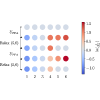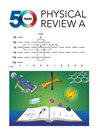Thermodynamic analysis of algorithmic cooling protocols: Efficiency metrics and improved designs
IF 2.9
2区 物理与天体物理
Q2 Physics and Astronomy
引用次数: 0
Abstract
Algorithmic cooling (AC) protocols have been predominantly studied for their cooling capabilities, with limited attention paid to their thermodynamic properties. This work explores an alternative perspective by analyzing a broad family of AC protocols from a thermodynamic standpoint. First, we give an in-depth review and formal classification of standard AC protocols. Leveraging the transfer matrix formalism, we achieve a consistent calculation of performance metrics, encompassing both cooling limits and target state evolution. We obtained a unification of these diverse cooling limits into a single, coherent mathematical expression, streamlining comparative analyses. Then, to assess the efficiency of coherent cooling protocols, we introduce two generic metrics: the coefficient of performance and Landauer's Ratio , and establish a direct interrelation. Applying these metrics, we thoroughly evaluate selected AC protocols, highlighting their relative strengths. Finally, we propose improved versions of AC protocols that exhibit enhanced thermodynamic performance, achieving desired target temperatures with lower work inputs. This research contributes to a deeper understanding of AC protocols and provides valuable insights for designing efficient cooling strategies in various applications.

算法冷却协议的热力学分析:效率指标和改进设计
对算法冷却(AC)协议的研究主要集中在其冷却能力上,对其热力学特性的关注有限。本研究从热力学的角度分析了大量 AC 协议,从而探索了另一种视角。首先,我们对标准交流协议进行了深入回顾和正式分类。利用传递矩阵形式主义,我们实现了性能指标的一致计算,包括冷却极限和目标状态演化。我们将这些不同的冷却极限统一为单一、连贯的数学表达式,从而简化了比较分析。然后,为了评估一致性冷却协议的效率,我们引入了两个通用指标:性能系数 K 和兰道尔比率 RL,并建立了直接的相互关系。应用这些指标,我们对选定的交流协议进行了全面评估,突出了它们的相对优势。最后,我们提出了交流协议的改进版本,这些版本具有更强的热力学性能,能以更低的功输入达到所需的目标温度。这项研究有助于加深对交流协议的理解,并为在各种应用中设计高效的冷却策略提供宝贵的见解。
本文章由计算机程序翻译,如有差异,请以英文原文为准。
求助全文
约1分钟内获得全文
求助全文
来源期刊

Physical Review A
物理-光学
CiteScore
5.40
自引率
24.10%
发文量
0
审稿时长
2.2 months
期刊介绍:
Physical Review A (PRA) publishes important developments in the rapidly evolving areas of atomic, molecular, and optical (AMO) physics, quantum information, and related fundamental concepts.
PRA covers atomic, molecular, and optical physics, foundations of quantum mechanics, and quantum information, including:
-Fundamental concepts
-Quantum information
-Atomic and molecular structure and dynamics; high-precision measurement
-Atomic and molecular collisions and interactions
-Atomic and molecular processes in external fields, including interactions with strong fields and short pulses
-Matter waves and collective properties of cold atoms and molecules
-Quantum optics, physics of lasers, nonlinear optics, and classical optics
 求助内容:
求助内容: 应助结果提醒方式:
应助结果提醒方式:


